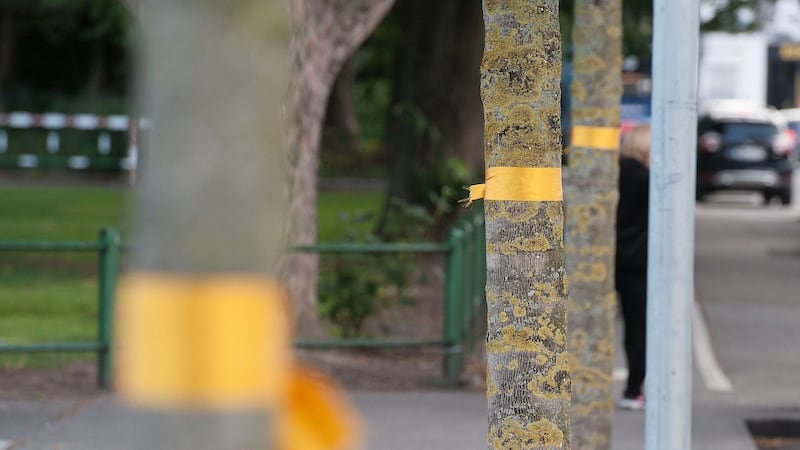The Dublin suburbs of Fairview and Marino get their historic names from fine views of Dublin Bay that its residents no longer enjoy. Those views disappeared many years ago due to land reclamation, railway building and all the other messy man-made interventions that go along with living close to a city's centre. For the same reasons there's not much sand on North Strand these days, and you won't need a boat to get to Usher's Island.
It’s a pleasant place, but its worst feature is the five-lane carriageway through which all rush-hour traffic from the northeastern suburbs must decant every day. This is mitigated to some degree by the fact the road is bounded on one side by a large municipal park created in the 1920s on what was previously mudflats.
The increase in the number of cycling commuters revealed by the recent census is clear in the amount of those speeding or gasping their way every day along the edge of the park towards work, school or college. At the moment they have an unsatisfactory choice: cycle in the bus lane or along a shared pedestrian/cycle path.
Now, as part of its programme for a segregated cycle route all the way into the centre, Dublin City Council is proposing to remove 49 trees from the footpath on the park's perimeter, prompting a protest petition that – as of yesterday afternoon – had received more than 9,000 signatures.
Who doesn't love trees? And what sort of monsters would want to cut them down?
Nine-thousand votes would get you handily elected to the Dáil from the constituency of Dublin Bay North, so it’s not to be politically sneezed at. Some local politicians have cautiously “entered into a debate” on social media on the petition, with others supporting it outright.
They shouldn’t. Not only is the petition itself wrongheaded, it’s symptomatic of the not-an-inch nimbyism and muddled thinking that is partly to blame for Dublin being such a bedraggled mess.
Sure, there are other reasons – the democratic vacuum in local government and the actions of unaccountable and aesthetically challenged engineers among them – but not enough attention is paid to the bloody-minded resistance of local residents to the most minimal change for the better.
Unlovable compromise
The truth is that, like most projects of this sort, the proposal is a compromise and not entirely beloved by anyone.
There are complex and contentious questions about access points and traffic flow. Cyclists’ groups would prefer a dedicated two-way route (which would presumably require an even more dramatic intervention to the streetscape).
The council, meanwhile, is proposing to plant almost three times as many new trees as it plans to remove.
None of that is reflected in the petition, which is illustrated by a photograph of some admittedly lovely trees in the middle of Fairview Park (none of which the council is proposing to remove), along with some dubious assertions about their historical provenance. But hey, who doesn't love trees? And what sort of monsters would want to cut them down?

But online sentimentality and one-click petitions ignore the fact that Fairview Park itself and the adjoining planned suburb of Marino were artificial landscapes, developed in the early years of the Free State as part of a clear-eyed vision of civic renewal and urban improvement. The idea that the area should be protected from the most gentle alterations regardless of new social and environmental challenges is absurd.
You don't need to go far to see the consequences of such folly. A couple of kilometres to the north, another stretch of the same cycle track at Dollymount was held up for years by protests, despite having been approved by An Bord Pleanála.
The complaints centred on the height of the proposed new sea wall adjoining the track, with local TD Finian McGrath declaiming in 2015 that “We won’t be backing off one inch until this matter has been fully resolved”.
That cycle lane is now finally open. If you cycle or walk along it, you’ll see that the sea is clearly visible to anyone over 4ft tall.
However, because of those protests, the council is now planning to spend €500,000 to reduce the wall’s height so that people in cars don’t have their view half-obscured for a couple of minutes. This is the sort of nonsense that now threatens to be repeated in Fairview.
Parking bays
The bleakest irony of all is that, despite all this, the northern leg of the proposed Sutton to Sandycove cycle track around Dublin Bay is still far more advanced than anything on the southside. And, in theory, providing better cycling facilities in the relatively wide open spaces of Fairview should be much easier than doing the same in the narrower streets closer to the centre. On other commuting routes through narrower Victorian suburbs, cycle lanes are routinely treated as parking bays by drivers who know they won’t be penalised.
If residents don't take on board new realities, then they face the prospect of Dublin Bay returning to their doorsteps
As the economic recovery gathers pace, the capital’s infrastructure is visibly creaking at the seams again; the housing crisis is the worst symptom, but cracked footpaths, snarled-up traffic and shabby signage all contribute to the impression of chronic underinvestment and inertia.
Meanwhile, stricter climate change measures will require a stronger, more interventionist approach to retool our cities for the post-internal combustion engine-era. Where the focus up to now has been on traffic and public transport in the city centre, there are big implications for the inner suburbs, which are currently choked with cars and commercial vehicles.
If people in those areas don’t take on board these new realities, then the residents of Fairview might be faced with the unwelcome prospect of Dublin Bay returning to their doorsteps after all those years.
Hugh Linehan is Culture Editor













